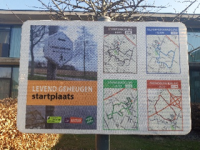martina
New member
- Table of contents
-
- Community private services
- Keywords
-
- Public place facilities (e.g. libraries or museums for people living with dementia)
Do you know that there exist cities suitable for people living with dementia?
Would you like to live in an inclusive and caring place, designed to meet your socialisation and safety needs?
Here are two examples:
1) In a village in Monza, Italy (1) a real village was built. Every building and public space was designed to promote independence of people living with dementia. Here you can find squares, streets, theatre, church, shops and everything else that is present in a city, designed to make you feel 'at home'.
2) In Kortrijk in Belgium (2), was created a route with benches and rest areas. Each area has information about the buildings and the history of a place. This is why it has been called the Reminescent Promenade.
 | What else can you do in order to make the neighbourhood more inclusive? Discuss with the community |
Do you know that there exist cities suitable for people living with dementia?
In order to make the place where you live inclusive and dementia friendly, it is possible to change the way cities and neighbourhoods are structured and make some adjustments to make them more inclusive. Some suggestions come from the Alzheimer Village "Il Paese Ritrovato" (1). This is a village in Monza (Italy) with protected flats for people living with dementia. Every space (streets, square, theatre, gardens, library, church, vegetable garden, etc.) is designed to be compatible with the disease and to give back the feeling of "being at home". This is an innovative, replicable project, which constitutes a new way of treatment.
In this environment there was improvement of symptoms of people with dementia; an improvement in mood, socialisation and active participation in stimulating activities, such as the community garden. This is the innovative aspect of the project.
Living in an environment that allows people living with dementia to safely choose how to spend their time is essential for their well-being and quality of life.
Some ideas can be summarised as follows:
- Make the environment as peaceful and reassuring as possible using colours.
- Make the environment accessible encouraging independence and orientation through clearly visible, clear road signs and markings, using cartoons and pictures.
- Avoid traffic, noise and any form of excessive stimulation
- Make different environments and services recognisable in their functions and easily accessible within walking distance of each other.
- Create recreational places and spaces that encourage socialisation
In order to make public places 'dementia friendly', another idea comes from the town of Aalbeke in Kortrijk (Belgium). Here, a path was created outside a retirement home called the 'Reminescent Promenade'. This is a promenade with reminiscence points. It includes information about buildings or monuments related to past events; people living with dementia can relive events from the past and talk about them. The objectives are both to make people with dementia part of the local daily life and to foster intergenerational dialogue, as the walk is open to everyone's participation.
Referencese:
https://cooplameridiana.it/centri_e_servizi/paese-ritrovato/
https://www.agefriendlyeurope.org/news/“go-back-time”-reminiscence-promenade-belgium
https://efid.info/casestudy/31-a-reminiscence-promenade-in-aalbeke-belgium/
https://www.kortrijk.be/agenda/e/levend-geheugen/035428a3-59a0-4e86-9bf7-d8aea1cd394f
Last edited:

